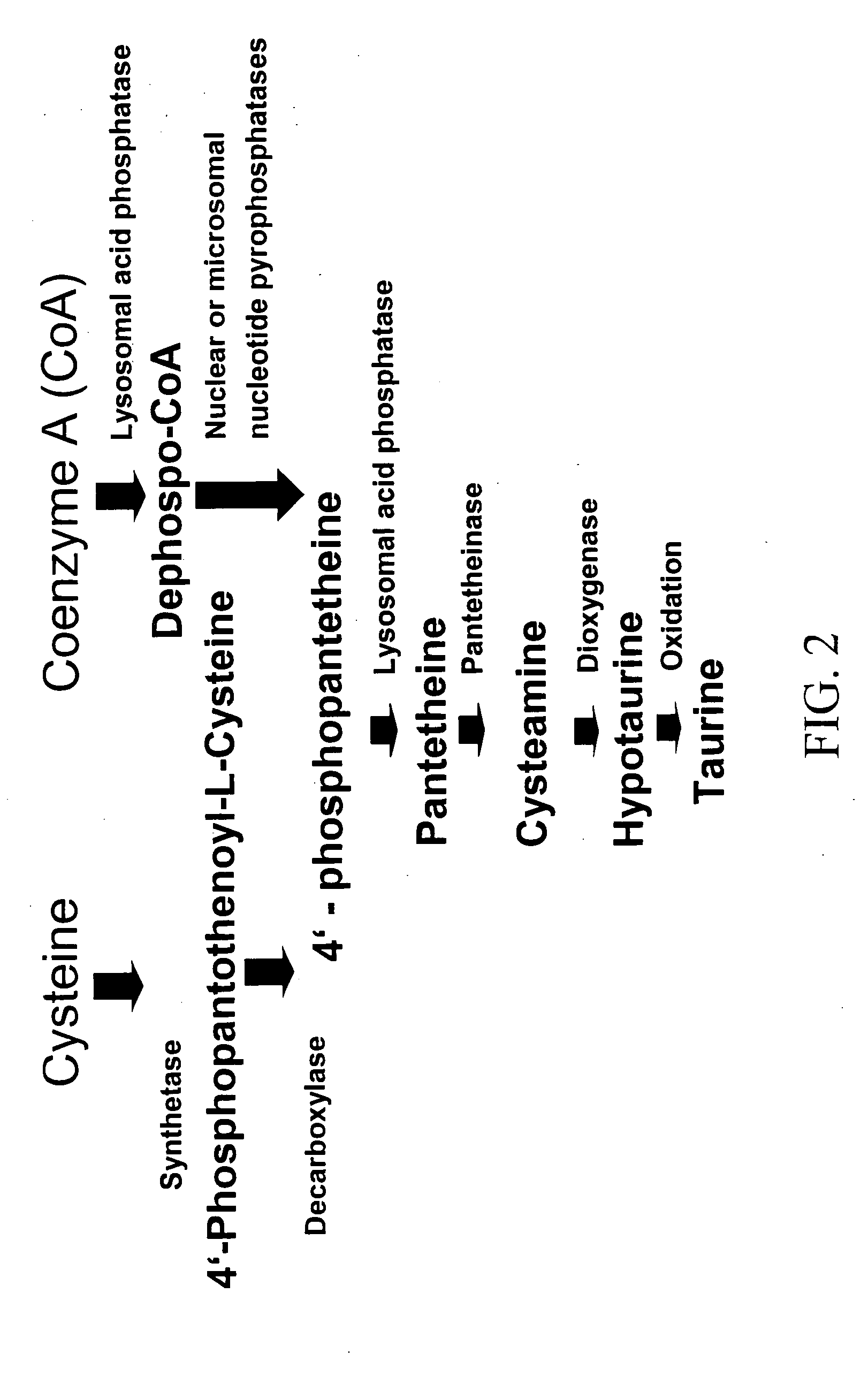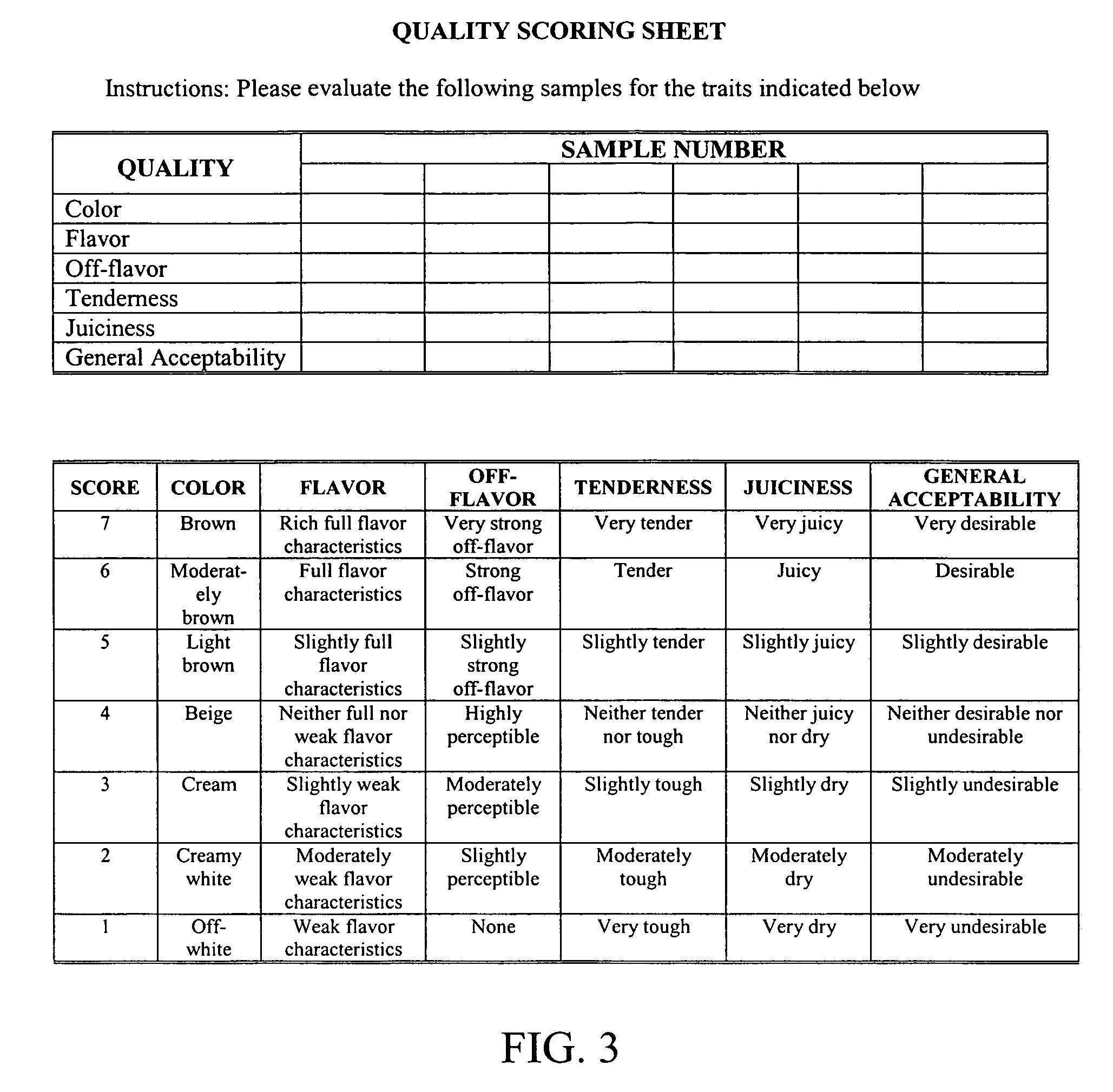Materials and methods for improving livestock productivity
- Summary
- Abstract
- Description
- Claims
- Application Information
AI Technical Summary
Benefits of technology
Problems solved by technology
Method used
Image
Examples
example 1
Enhanced Productivity in Swine
[0082] The following example was performed to demonstrate the effect on pregnant pig sows when fed a cysteamine compound that is described in greater detail below. A total of 14 heads of pregnant pig sow (which were the offspring of Duroc×Landrace×Meishan swine, also referred to herein as D×L×M hybrid swine) (84 days of pregnant) were divided into 2 groups: Control group (6) and Cysteamine group (8). The Control group was fed with basal diet. The Cysteamine group was fed with basal diet containing 150 g cysteamine hydrochloride per ton feed. After 49 days of the trial, the results illustrated in Table 3 below demonstrate that the Cysteamine group had an increase of 13.28% in litter weight, 12.43% increase in piglet born weight and 8.00% increase in weaning weight.
TABLE 3Effect of Cysteamine Hydrochloride on Swine ProductivityImprovementItemsControlCysteamineImprovement(%)AnimalLate phase pregnant sowDosage (g / T)0500——Population (head)68——Trial period...
example 2
Enhanced Growth in Swine
[0083] The following example was performed to demonstrate the effect on weaning piglets when fed a cysteamine compound that is described in greater detail below. Total of 100 heads of unhealthy D×L×M weanling piglets (approx. 6.78 kg) were divided into 2 groups—Control group (50 heads) & Cysteamine group (50 heads). The Control group was fed with basal diet. The Cysteamine group was fed with basal diet containing 90 g of cysteamine hydrochloride per ton of feed. As illustrated in Table 4 below, after 30 days of the trial, the results showed that the Cysteamine group had an increase of 12.83% in average daily weight gain (ADG), a decrease of 5.56% in feed conversion rate (FCR) and 43.24% improvement in diarrhea condition.
TABLE 4Effect of Cysteamine Hydrochloride on Weaning PigletsImprovementItemControlCysteamineImprovement(%)AnimalDxLxM weanling pigletsTreatment300 ppmPopulation (head)5050—Trial days3030—Initial Wt. (kg / head)6.756.8—Final Wt. (kg / head)17.96...
example 3
Carcass Composition / Appearance in Swine
[0084] The following example was performed to demonstrate the effect on pig carcass composition and appearance after being fed a cysteamine compound that is described in greater detail below. 72 piglets were divided evenly into control group and Cysteamine group. The control group was treated with basal diet while the Cysteamine group was treated with basal diet added with 150 g cysteamine hydrochloride per ton of feed. Upon reaching the market weight of 85-90 kg, five animals from each treatment were slaughtered after fasting for one day. During slaughter, the animals were stunned with a stunning gun, bled, dehaired and eviscerated. The carcass was split into minus the head and then chilled for 24 hours prior to fabrication. The slaughter and the chilled carcass weights were recorded. The chilled carcass weight expressed as percentage of the slaughter weight represents the dressed yield. The wholesale and retail cuts of each animals were weig...
PUM
| Property | Measurement | Unit |
|---|---|---|
| Fraction | aaaaa | aaaaa |
| Fraction | aaaaa | aaaaa |
| Mass | aaaaa | aaaaa |
Abstract
Description
Claims
Application Information
 Login to View More
Login to View More - R&D
- Intellectual Property
- Life Sciences
- Materials
- Tech Scout
- Unparalleled Data Quality
- Higher Quality Content
- 60% Fewer Hallucinations
Browse by: Latest US Patents, China's latest patents, Technical Efficacy Thesaurus, Application Domain, Technology Topic, Popular Technical Reports.
© 2025 PatSnap. All rights reserved.Legal|Privacy policy|Modern Slavery Act Transparency Statement|Sitemap|About US| Contact US: help@patsnap.com



